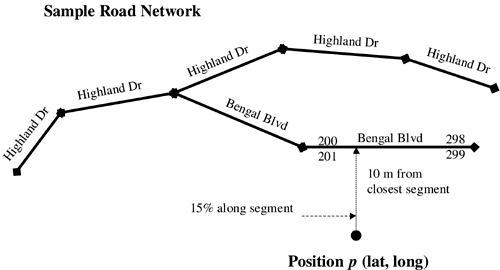Reverse Geocoding
| Reverse geocoding is the process of identifying the nearest road segment in a map database given a latitude and longitude pair. This latitude and longitude data would typically be generated by the mobile device's positioning system. Once the nearest road segment is available it is possible to process driving or walking direction requests or POI lookups. The operation is specific to a given map database, and different map databases of the same area could yield different results. The operation usually searches for road segments within a specified range, which might or might not be configurable by the user. You must be cautious with the search range, as a range that is too small can return errors if the user is trying to use an application from a park or other open space area that has no road segments, but is located in an urban area. Information returned by a successful reverse geocode operation might include how far the nearest road segment is from the point, where the point is in relation to the road segment (near the beginning of the address range, 15 percent; in the middle of the address range, 50 percent, or near the end of the address range, 85 percent), and the actual road segment vector data and its associated attributes. See Figure 4.13 for an example. Figure 4.13. Reverse Geocoding Example. |
EAN: 2147483647
Pages: 150
